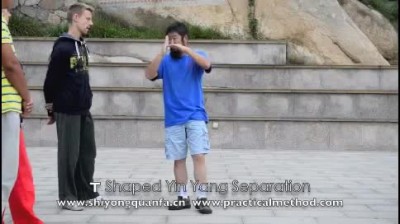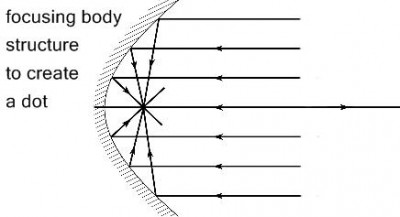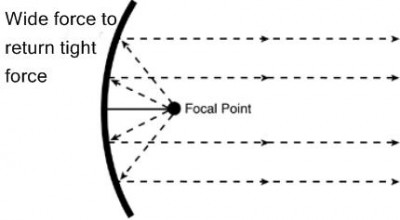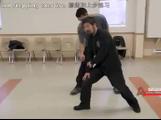bruce.schaub
‘ Behind Enemy Lines ‘
This is an expression Master Chen uses that I find particularly helpful in understanding the procedure for utilizing the method of fighting taught in the recent video ‘ Move into empty space ‘.
Engage the opponent
… this creates a ‘ front line ‘ like on a battlefield, causing the opponent to commit his troops to maintain that line. This is the same as the demarcation line. The key seems to be to cause the opponent to commit enough of his ‘ forces ‘ and attention to preoccupy him, while you move to step 2
Move into empty space ( Go behind enemy lines )
…. while maintaining the front line, you must use stealth to maneuver, another force to take up a position behind enemy lines, ( beyond the demarcation ( front line ) by moving into the empty space. The keys are, you must maintain the front line, the movement of the secondary forces must neither disturb the front line, nor should they be construed as a threat. In keeping with taiji threory, if the two ends are locked ( non moving ) this requires we move whats in the middle, ideally getting the kua in, (kua to kua)
Master Chen often talks about having concave curve in the body. It sounds to me like he is describing a parabolic reflector. It’s a concave mirror essentially that reflects energy, that comes in, back toward a single focal point. Parabolic structure is also used to reflect a point of light into a diffuse light.
In relation to Taiji training, Master CHen is talking about correct alignment and orientation of the joints of the body, and how often when we think we are in the ‘ correct ‘ position, we are actually quite chaotically misaligned, and lack proper orientation. There is no focal point.
My understanding of what he means is that in the correct structure of the ‘ mother move ‘ of Practical Method all the joints power should be aiming to a central dot. That dot will have cumulative power similar to the idea of the collective beam of concentrated energy from a Parabolic reflector.
In workshop Master Chen also demo about breaking opponent incoming diffuse force with a tight force and vice versa: the concave shape also facilitate this.
 Although there are not really ‘ secrets ‘ in Taiji anymore, there are things that are extremely important, that are not well known or properly emphasized. Generally speaking, students are not shown ‘ leg methods ‘ until they are higher level, if ever. The correct ( and stealth like ) use of the leg is Read more
Although there are not really ‘ secrets ‘ in Taiji anymore, there are things that are extremely important, that are not well known or properly emphasized. Generally speaking, students are not shown ‘ leg methods ‘ until they are higher level, if ever. The correct ( and stealth like ) use of the leg is Read more
Dan Tian and Kua
 In a Phoenix Workshop a couple years ago, Master Chen talked about different schools of thought related to the concept of ” Setting Up the Furnace “. This has to do with the formation of a real and working Dantien. One school of thought believes, this is done energetically and when formed causes changes in the Read more
In a Phoenix Workshop a couple years ago, Master Chen talked about different schools of thought related to the concept of ” Setting Up the Furnace “. This has to do with the formation of a real and working Dantien. One school of thought believes, this is done energetically and when formed causes changes in the Read more
 One of the lessons Master Chen elaborated on at the recent New York workshop was the principle in taiji of training from ‘ Square to Round ‘. This is an abbreviation that describes the difference in the body ( and the resulting changes ) that are the result of training the foundational method of Yilu vs. Cannon Fist , which is the implementation of foundation , applied in martial technique.
One of the lessons Master Chen elaborated on at the recent New York workshop was the principle in taiji of training from ‘ Square to Round ‘. This is an abbreviation that describes the difference in the body ( and the resulting changes ) that are the result of training the foundational method of Yilu vs. Cannon Fist , which is the implementation of foundation , applied in martial technique.
The more full expression of ‘ square to round ‘ , that was discussed in the workshop, was that, in the Yilu, ” …..the inside is ‘ square ‘ and the outside is ‘ round ‘….. “, meaning the inside linear movements apprear as a circular move on the outside, and that in Erlu ( cannon fist ) , ” …..the inside is ‘ round ‘, and the outside is ‘ square ‘…..”, meaning the rotation of the inner core, is circular, but the outside of the body must have the ability to fold or ‘wrap’ around corners ( square ).
Although this is really a very big subject requiring a lot of explanation, the following video helps to put these expressions into perspective.
http://practicalmethod.com/2014/10/t-shaped-yin-yang-separation-online-video-purchase/
 Taiji can certainly be considered a form of specialized technology, and like any specialized technology, this requires special language.
Taiji can certainly be considered a form of specialized technology, and like any specialized technology, this requires special language.
That language is something we have to be very careful of because, in many cases, a word with a ‘common’ meaning often has a special, more extensive, or more precise meaning than the one we would normally attribute to it.
Sometimes watching something in nature can be helpful in gaining understanding a type of movement. If you watch generally speaking you see ‘everything moving’ in a wavelike manner. But if you look more closely you will notice the movement is actually the result of a sequence of isolated actions connected by stretch. Every thing is NOT moving at the same time. There is an energy flow through the segments.
Here is a pretty good example of the power of yin yang separation. Because there is a lot of power involved you can see (and feel) the difference very clearly. The video is of me operating a backhoe briefly. First I operate the backhoe arm without stabilizing the machine. The tractor tosses wildly and much of the power of the arm is lost. This is called energy being “dispersed”. Then I stabilize the machine and operate the arm. The power is greatly increased. This is called energy being “clear” and or “pure”. The difference in power extremely easy to feel, and I think is quite visually apparent. It is the direct result of the machine “not moving” while the arm is operated and moves freely (yin yang separation)
 No problem, I really appreciate the opportunity to participate in these discussions. It helps to solidify my understanding of things as I study videos and practice. One of the videos that helped clarify one of the main contradictions/sources of confusion is the mini lesson “Hands on Positive Circle Sequence” where Master Chen is detailing the 9 count circle for you, Michael, and a small group of students on the mountain. Read more
No problem, I really appreciate the opportunity to participate in these discussions. It helps to solidify my understanding of things as I study videos and practice. One of the videos that helped clarify one of the main contradictions/sources of confusion is the mini lesson “Hands on Positive Circle Sequence” where Master Chen is detailing the 9 count circle for you, Michael, and a small group of students on the mountain. Read more
Please leave comments on my form




